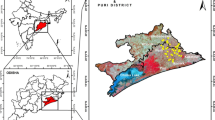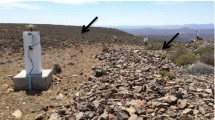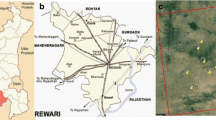Abstract
Flood generation in mountainous headwater catchments is governed by rainfall intensities, by the spatial distribution of rainfall and by the state of the catchment prior to the rainfall, e.g. by the spatial pattern of the soil moisture, groundwater conditions and possibly snow. The work presented here explores the limits and potentials of measuring soil moisture with different methods and in different scales and their potential use for flood simulation. These measurements were obtained in 2007 and 2008 within a comprehensive multi-scale experiment in the Weisseritz headwater catchment in the Ore-Mountains, Germany. The following technologies have been applied jointly thermogravimetric method, frequency domain reflectometry (FDR) sensors, spatial time domain reflectometry (STDR) cluster, ground-penetrating radar (GPR), airborne polarimetric synthetic aperture radar (polarimetric SAR) and advanced synthetic aperture radar (ASAR) based on the satellite Envisat. We present exemplary soil measurement results, with spatial scales ranging from point scale, via hillslope and field scale, to the catchment scale. Only the spatial TDR cluster was able to record continuous data. The other methods are limited to the date of over-flights (airplane and satellite) or measurement campaigns on the ground. For possible use in flood simulation, the observation of soil moisture at multiple scales has to be combined with suitable hydrological modelling, using the hydrological model WaSiM-ETH. Therefore, several simulation experiments have been conducted in order to test both the usability of the recorded soil moisture data and the suitability of a distributed hydrological model to make use of this information. The measurement results show that airborne-based and satellite-based systems in particular provide information on the near-surface spatial distribution. However, there are still a variety of limitations, such as the need for parallel ground measurements (Envisat ASAR), uncertainties in polarimetric decomposition techniques (polarimetric SAR), very limited information from remote sensing methods about vegetated surfaces and the non-availability of continuous measurements. The model experiments showed the importance of soil moisture as an initial condition for physically based flood modelling. However, the observed moisture data reflect the surface or near-surface soil moisture only. Hence, only saturated overland flow might be related to these data. Other flood generation processes influenced by catchment wetness in the subsurface such as subsurface storm flow or quick groundwater drainage cannot be assessed by these data. One has to acknowledge that, in spite of innovative measuring techniques on all spatial scales, soil moisture data for entire vegetated catchments are still today not operationally available. Therefore, observations of soil moisture should primarily be used to improve the quality of continuous, distributed hydrological catchment models that simulate the spatial distribution of moisture internally. Thus, when and where soil moisture data are available, they should be compared with their simulated equivalents in order to improve the parameter estimates and possibly the structure of the hydrological model.













Similar content being viewed by others
References
Aubert D, Loumagne C, Oudin L (2003) Sequential assimilation of soil moisture and streamflow data in a conceptual rainfall-runoff model. J Hydrol 280:145–161
Baghdadi N, Holah N, Zribi M (2006) Soil moisture estimation using multi-incidence and multi-polarization ASAR data. Int J Remote Sens 27(10):1907–1920
Berthet L, Andréassian V, Perrin C, Javelle P (2009) How crucial is it to account for the antecedent moisture conditions in flood forecasting? Comparison of event-based and continuous approaches on 178 catchments. Hydrol Earth Syst Sci 13:819–831. doi:10.5194/hess-13-819-2009
Beven KJ, Kirkby MJ (1979) A physically based, variable contributing area model of basin hydrology. Hydrol Sci J 24(1):43–69
Blöschl G, Sivapalan M (1995) Scale issues in hydrological modelling: a review. Hydrol Proc 9:251–290
Borga M, Boscolo P, Zanon F, Sangati M (2007) Hydrometeorological analysis of the August 29, 2003 flash flood in the eastern Italian Alps. J Hydrometeorol 8(5):1049–1067
Brocca L, Melone F, Moramarco T, Morbidelli R (2009) Antecedent wetness conditions based on ERS scatterometer data. J Hydrol 364(1–2):73–87
Bronstert A (2005) Abflussbildung. Forum für Hydrologie und Wasserbewirtschaftung, Heft 12
Bronstert A, Bárdossy A (1999) The role of spatial variability of soil moisture for modelling surface runoff generation at the small catchment scale. Hydrol Earth Syst Sci 3(4):505–516
Bronstert A, Bárdossy A (2003) Uncertainty of runoff modeling at the hillslope scale due to temporal variations of rainfall intensity. Phys Chem Earth 28:283–288
Cassiani G, Binley A, Ferré TPA (2006) Unsaturated zone processes. In: Verrecken H, Binley A, Cassini G Revil A, Titov C (eds) Applied hydrogeophysics, NATO science series, IV. Eart and environmental sciences, vol 71. Springer, Dordrecht
Choi M, Jacobs JM, Cosh MH (2007) Scaled spatial variability of soil moisture fields. Geophys Res Lett 34:L01401. doi:10.1029/2006GL028247
Cloude SR, Pottier E (1996) A review of target decomposition theorems in radar polarimetry. IEEE Trans Geosci Remote Sens 34(2):498–518
Cloude SR, Pottier E (1997) An entropy based classification scheme for land applications of polarimetric SAR. IEEE Trans Geosci Remote Sens 35(1):68–78
Cloude SR, Fortuny J, Lopez-Sanchez JM, Sieber AJ (1999) Wide-Band Polarimetric Radar Inversion Studies for Vegetation Layers. IEEE Trans Geosci Remote Sens 37(5):2430–2441
Collier CG (2007) Flash flood forecasting: what are the limits of predictability? Q J R Meteorol Soc 133(622):3–23
Corwin DL, Hopmans J, de Rooij GH (2006) From field- to landscape-scale vadose zone processes: scale issues, modeling, and monitoring. Vadose Zone J 5(1):129–139
Crow WT, Ryu D (2009) A new data assimilation approach for improving runoff prediction using remotely-sensed soil moisture retrievals. Hydrol Earth Syst Sci 13(1):1–16
Crow WT, Bindlish R, Jackson TJ (2005) The added value of spaceborne passive microwave soil moisture retrievals for forecasting rainfall-runoff ratio partitioning. Geophys Res Lett 32:L18401. doi:10.1029/2005GL023543
Dunne T, Moore TR, Taylor CH (1975) Recognition and prediction of runoff producing zones in humid regions. Hydrol Sci Bull 20(3):305–327
Ehret U (2003) Rainfall and flood nowcasting in small catchments using weather radar. Mitteilungen Institut für Wasserbau, Universität Stuttgart
Evett SR, Schwartz RC, Tolk JA, Howell TA (2009) Soil profile water content determination: spatiotemporal variability of electromagnetic and neutron probe sensors in access tubes. Vadose Zone J 8:926–941. doi:10.2136/vzj2008.0146
Fedora MA, Beschta RL (1989) Storm runoff simulation using an antecedent precipitation index (API) model. J Hydrol 112(1–2):121–133
Feng W, Lin CP, Deschamps RJ, Drnevic VP (1999) Theoretical model of a multisection time domain reflectometry measurement system. Wat Resour Res 35(8):2321–2331
Francois C, Quesney A, Ottle C (2003) Sequential assimilation of ERS-1 SAR data into a coupled land surface-hydrological model using an extended Kalman filter. J Hydrometeorol 4(2):473–487
Freeman A, Durden SL (1998) A three-component scattering model for polarimetric SAR data. IEEE Trans Geosci Remote Sens 36(3):963–973
Galagedara LW, Parkin GW, Redman JD, von Bertoldi P, Endres AL (2005a) Field studies of the GPR ground wave method for estimating soil water content during irrigation and drainage. J Hydrol (Amsterdam) 301:182–197
Galagedara LW, Redman JD, Parkin GW, Annan AP, Endres AL (2005b) Numerical modeling of GPR to determine the direct ground wave sampling depth. Vadose Zone J 4:1096–1106
Gaskin GJ, Miller JD (1996) Measurement of soil water content using a simplified impedance measuring technique. J Agric Res 63:153–160
Goodrich DC, Schmugge TJ, Jackson TJ, Unkrich CL, Keefer TO, Parry R, Bach LB, Amer SA (1994) Runoff simulation sensitivity to remotely-sensed initial soil water content. Wat Resour Res 30(5):1393–1405
Graeff T, Zehe E, Schlaeger S, Morgner M, Bauer A, Becker R, Creutzfeldt B, Bronstert A (2010) A quality assessment of Spatial TDR soil moisture measurements in homogenous and heterogeneous media with laboratory experiments. Hydrol Earth Syst Sci 14:1007–1020
Grayson R, Blöschl G (eds) (2001) Spatial patterns in catchment hydrology observations and modelling. Cambridge University Press, Cambridge
Greco R (2006) Soil water content inverse profiling from single TDR waveforms. J Hydrol 317:325–339
Grote K, Hubbard S, Rubin Y (2002) Field-scale estimation of volumetric water content using GPR groundwave techniques. Wat Resour Res 39(11):1321. doi:10.1029/2003WR002045
Gurtz J, Zappa M, Jasper K, Lang H, Verbunt M, Badoux A, Vitvar T (2003) A comparative study in modelling runoff and its components in two mountainous catchments. Hydrol Process 17:297–311
Hajnsek I, Pottier E, Cloude SR (2003) Inversion of surface parameters from polarimetric SAR. IEEE Trans Geosci Remote Sens 41(4):727–744
Hajnsek I, Jagdhuber T, Schön H, Papathanassiou KP (2009) Potential of estimating soil moisture under vegetation cover by means of PolSAR. IEEE Trans Geosci Remote Sens 47(2):442–454
Harter T, Zhang D (1999) Water flow and solute spreading in heterogeneous soils with spatially variable water content. Wat Resour Res 35(2):415–426
Herkelrath WN, Hamburg SP, Murphy F (1991) Automatic real-time monitoring of soil moisture in a remote field area with time domain reflectometry. Wat Resour Res 27(5):857–864
Huisman JA, Sperl C, Bouten W, Verstraten JM (2001) Soil water content measurements at different scales: accuracy of time domain reflectometry and ground-penetrating radar. J Hydrol 245(1):48–58
Huisman JA, Snepvangers JJJC, Bouten W, Heuvelink GBM (2002) Mapping spatial variation in surface soil water content: comparison of ground-penetrating radar and time domain reflectometry. J Hydrol 269(3–4):194–207
Huisman JA, Hubbard S, Redman JD, Annan AP (2003) Measuring soil water content with ground penetrating radar: a review. Vadose Zone J 16:476–491
Jacobs JM, Meyers DA, Whitfield BM (2003) Improved rainfall/runoff estimates using remotely-sensed soil moisture. J Am Water Resour Ass 39(2):313–324
Jagdhuber T, Schön H, Hajnsek I, Papathanassiou KP (2009) Soil moisture estimation under vegetation applying polarimetric decomposition techniques. Proceedings of the 4th international workshop on science and applications of SAR polarimetry and polarimetric interferometry, Frascati, Italy, pp 1–8
Klok EJ, Jasper K, Roelofsma KP, Gurtz J, Badoux A (2001) Distributed hydrological modelling of a heavily glaciated Alpine river basin. Hydrol Sci J 46(4):553–570
Koyama C, Korres W, Fiener P, Schneider K (2010) Variability of surface soil moisture observed from multitemporal C-band synthetic aperture radar and field data. Vadose Zone J 9(4):1014–1024
Lakshmi V (2004) The role of satellite remote sensing in the prediction of ungauged basins. Hydrol Process 18(5):1029–1034
Lee J-S, Pottier E (2009) Polarimetric radar imaging from basics to applications. Taylor & Francis, Boca Raton
Lesmes DP, Friedman SP (2005) Relationships between the electrical and hydrogeological properties of rocks and soils, chap. 4. In: Rubin Y, Hubbard SS (eds) Hydrogeophysics. Springer, Dordrecht, pp 87–128
Marchi L, Borga M, Preciso E, Gaume E (2010) Characterisation of selected extreme flash floods in Europe and implications for flood risk management. J Hydrol 394(1–2):118–133
Martinez C, Hancock GR, Kalma J, Wells Z (2008) Spatio-temporal distribution of near-surface and root zone soil moisture at the catchment scale. Hydrol Process 22:2699–2714
Merz B, Bárdossy A (1998) Effects of spatial variability on the rainfall runoff process in a small loess catchment. J Hydrol 213(1–4):304–317
Merz B, Plate E (1997) An analysis of the effects of spatial variability of soil and soil moisture on runoff. Water Resour Res 33(12):2909–2922
Noto LV, Ivanov VY, Bras RL, Vivoni ER (2008) Effects of initialization on response of a fully-distributed hydrologic model. J Hydrol 352(1–2):107–125
Oswald B, Benedickter HR, Bächtold W, Flühler H (2003) Spatially resolved water content profiles from inverted time domain reflectometry signals. Wat Resour Res 39(12):1357
Parajka J, Naemi V, Blöschl G, Wagner W, Merz R, Scipal K (2006) Assimilating scatterometer soil moisture data into conceptual hydrologic models at coarse scales. Hydrol Earth Syst Sci 10:353–368
Pauwels RN, Hoeben R, Verhoest NEC, De Troch FP, Troch PA (2002) Improvements of TOPLATS-based discharge predictions through assimilation of ERS-based remotely-sensed soil moisture values. Hydrol Proc 16:995–1013
Pilgrim DH, Cordery I (1993) Flood runoff. In: Maidment DR (ed) Handbook of hydrology. McGraw-Hill, Inc., New York
Refsgaard JC (1997) Validation and intercomparison of different updating procedures for real-time forecasting. Nordic Hydrol 28:65–84
Robinson DA, Jones SB, Wraith JM, Or D, Friedman SP (2003) A review of advances in dielectric and electrical conductivity measurement in soils. Vadose Zone J 2:444–475
Robinson DA, Abdu H, Jones SB, Seyfried M, Lebron I, Knight R (2008a) Soil moisture measurement for ecological and hydrological watershed-scale observatories: a review. Vadose Zone J 7:358–389
Robinson DA, Campbell JW, Hopmans BK, Hornbuckle SB, Jones R, Knight R, Odgen R, Selker J, Wendroth O (2008b) Eco-geophysical imaging of watershed-scale soil patterns links with plant community spatial patterns. Vadose Zone J 7:1132–1138
Ryu D, Famiglietti JS (2005) Characterization of footprint-scale surface soil moisture variability using Gaussian and beta distribution functions during the Southern Great Plains 1997 (SGP97) hydrology experiment. Water Resour Res 41(12), W12433. doi:10.1029/2004WR003835
Schlaeger S (2005) A fast TDR-inversion technique for the reconstruction of spatial soil moisture content. Hydrol Earth Syst Sci 9:481–492
Schmalholz J (2007) Georadar for small-scall high-resolution dielectric property and water content determination of soils. Technische Universität, Berlin
Schulla J (1997) Hydrologische Modellierung von Flussgebieten zur Abschätzung der Folgen von Klimaänderungen. Züricher Geographische Schriften, ETH Zürich
Schulla J, Jasper K (2007) Model description WaSiM-ETH. Technical report, Zürich
Taumer K, Stoffregen H, Wessolek G (2006) Seasonal dynamics of preferential flow in a water repellent soil. Vadose Zone J 5(1):405–411
Uhlenbrook S, Leibundgut C (2002) Process-oriented catchment modeling and multiple-response validation. Hydrol Proc 16:423–440
Van Overmeeren RA, Sariowan SV, Gehrels JC (1997) Ground penetrating radar for determining volumetric soil water content: results of comparative measurements at two test sites. J Hydrol 197:316–338
van Zyl JJ, Arii M, Ki Y (2008) Requirements for model-based polarimetric decompositions. Proceedings of the 7th European conference on synthetic aperture radar (EUSAR), Friedrichshafen, Germany, pp 41–44
Vereecken H, Kamai T, Harter T, Kasteel R, Hopmans J, Vanderborght J (2007) Explaining soil moisture variability as a function of mean soil moisture: a stochastic unsaturated flow perspective. Geophys Res Lett 34:L22402. doi:10.1029/2007GL031813
Vereecken H, Huisman JA, Bogena H, Vanderborght J, Vrugt JA, Hopmans JW (2008) On the value of soil moisture measurements in vadose zone hydrology: a review. Wat Resour Res 44:W00D06. doi:10.1029/2008WR006829
Wagner W, Blöschel G, Pampaloni P, Calvet J-C, Bizarri B, Wigneron J-P, Kerr Y (2004) Operational readiness of microwave remote sensing of soil moisture for hydrologic applications. Nordic Hydrol 38(1):1–20
Weihermuller L, Huisman JA, Lambot S, Herbst M, Vereecken H (2007) Mapping the spatial variation of soil water content at the field scale with different ground penetrating radar techniques. J Hydrol 340(3–4):205–216
Weiler M, McDonnell JJ (2007) Conceptualizing lateral preferential flow and flow networks and simulating the effects on gauged and ungauged hillslopes. Water Resour Res 43:W03403
Weissling BP, Xie H, Murray KE (2007) A multitemporal remote sensing approach to parsimonious streamflow modeling in a southcentral Texas watershed, USA. Hydrol Earth Syst Sci 4:1–33
Western A, Grayson R, Blöschl G (2002) Scaling of soil moisture: a hydrologic perspective. Ann Rev Earth Planet Sci 30:149–180
Wollny K (1999) Die Natur der Bodenwelle des Georadar und ihr Einsatz zur Feuchtebestimmung. Utz, Wiss., München
Yamaguchi Y, Moriyama T, Ishido M, Yamada H (2005) Four-component scattering model for polarimetric SAR image decomposition. IEEE Trans Geosci Remote Sens 43(8):1699–1706
Younis J, Anquetin S, Thielen J (2008) The benefit of high-resolution operational weather forecasts for flash flood warning. Hydrol Earth Syst Sci 12(4):1039–1051
Zehe, E., Blöschl, G. (2004) Predictability of hydrologic response at the plot and catchment scales—the role of initial conditions. Water Resour Res 40(10):W10202. doi:10.1029/2003WR002869
Zehe E, Becker R, Bárdossy A, Plate E (2005) Uncertainty of simulated catchment sale runoff response in the presence of threshold processes: role of initial soil moisture and precipitation. J Hydrol 315(1–4):183–202
Acknowledgments
This research has been conducted as part of the project OPAQUE (operational discharge and flooding predictions in head catchments), a project funded by the German Federal Ministry of Education and Research within the research programme RIMAX (‘Risk Management of Extreme Flood Events’). This financial support is gratefully acknowledged, as well as the further funding of measurement equipment and technical support from the University of Potsdam and the GFZ German Research Centre for Geosciences. We thank Thomas Recknagel for conducting the WASIM-ETH simulations. Furthermore, we thank two anonymous reviewers for their clear and constructive comments to an earlier version of this paper.
Author information
Authors and Affiliations
Corresponding author
Rights and permissions
About this article
Cite this article
Bronstert, A., Creutzfeldt, B., Graeff, T. et al. Potentials and constraints of different types of soil moisture observations for flood simulations in headwater catchments. Nat Hazards 60, 879–914 (2012). https://doi.org/10.1007/s11069-011-9874-9
Received:
Accepted:
Published:
Issue Date:
DOI: https://doi.org/10.1007/s11069-011-9874-9




